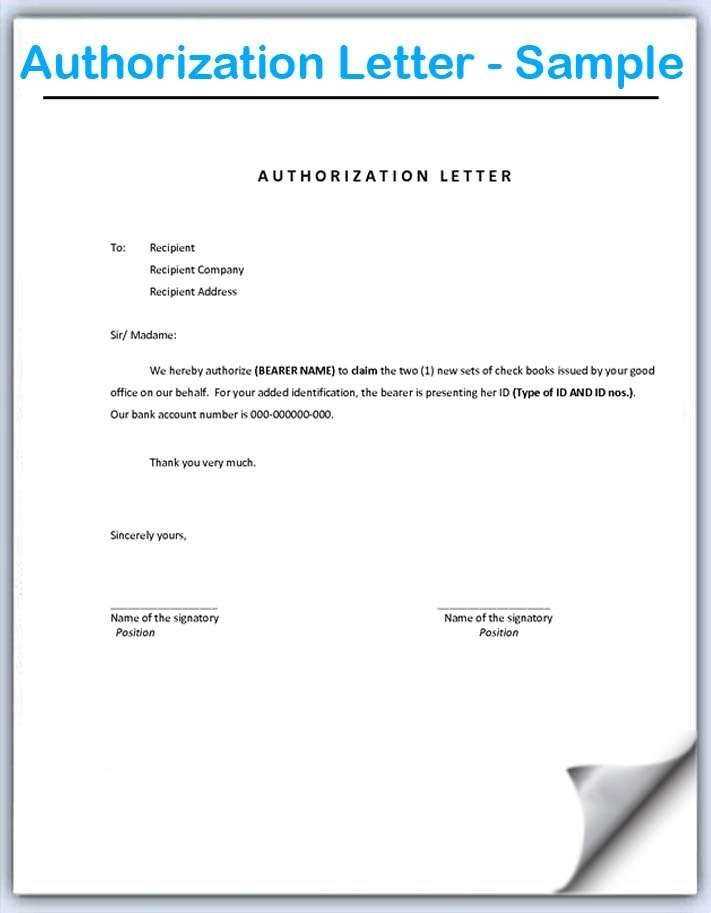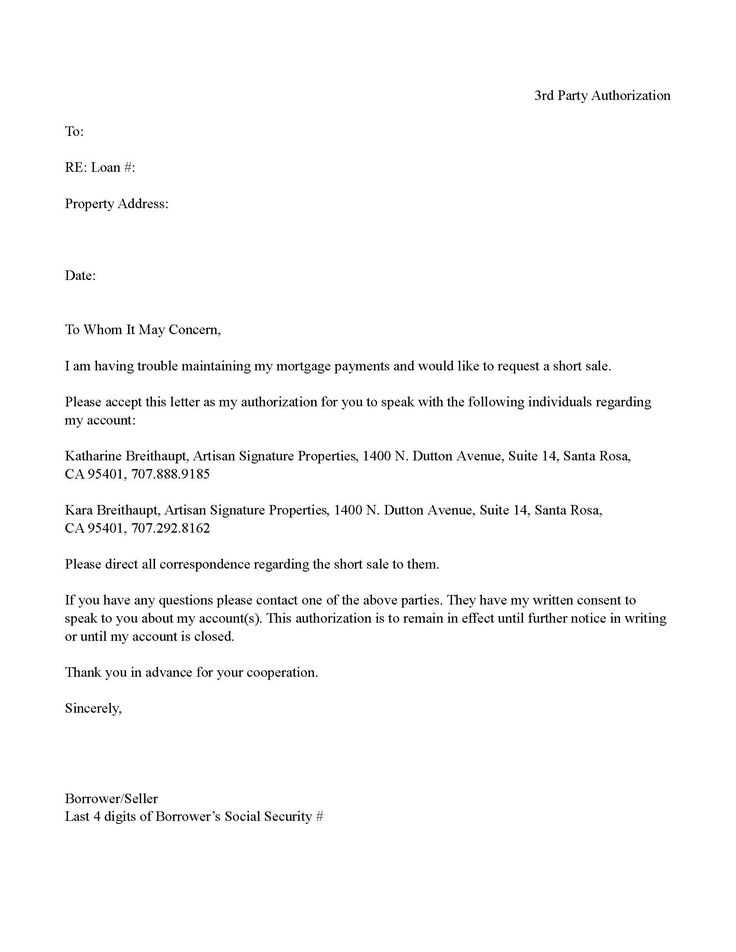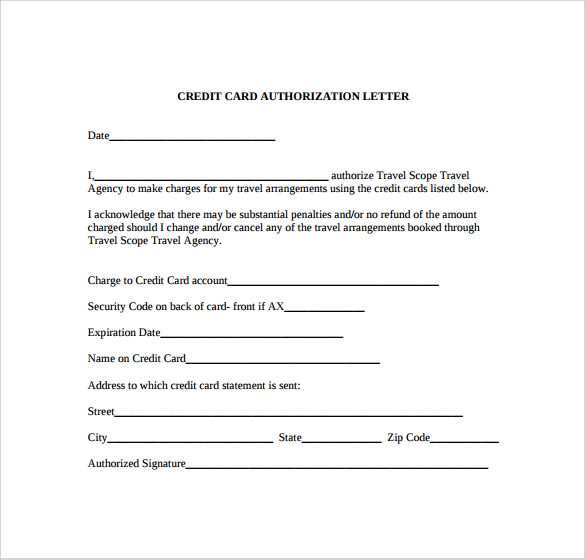Business authorization letter template

A well-crafted authorization letter is a simple but powerful tool to grant someone the ability to act on your behalf in business matters. Whether you’re delegating tasks, authorizing access to sensitive information, or permitting a representative to handle legal or financial activities, having a clear and professional template can save time and prevent confusion. This template ensures all key details are covered, reducing the risk of errors or misunderstandings.
Start by clearly identifying both the grantor and the authorized party. Be specific about the tasks or permissions being granted. Include dates, locations, and any limits to the scope of authority. A straightforward structure will keep the document clear and legally sound. Always specify the reason for authorization and ensure that both parties sign and date the letter for validity.
The template you choose should include all necessary legal elements, with no room for ambiguity. By using a reliable authorization letter format, you create a document that is both formal and practical, giving others confidence in the authority granted. This template will guide you in drafting a document that works for any business situation, from routine tasks to more complex delegations.
Here’s the corrected version:
When drafting a business authorization letter, clarity is key. It should be short, clear, and specific about the actions you’re authorizing. Here’s a structure you can follow:
- Introduction: Start by clearly identifying yourself as the person granting authorization and provide your business details.
- Details of Authorization: Specify what the authorized person is allowed to do. Be precise with the tasks or decisions they can make on your behalf.
- Authorization Period: Mention any time frame or specific dates for which the authorization is valid.
- Signature: Your signature at the end confirms that the letter is legitimate.
- Contact Information: Include your phone number or email in case further verification is needed.
Here’s an example template:
[Your Name] [Your Position] [Company Name] [Address] [City, State, ZIP] [Date] To Whom It May Concern, I, [Your Name], hereby authorize [Authorized Person’s Name], holding the position of [Authorized Person’s Position], to act on my behalf for [specific actions/tasks]. This authorization is valid from [Start Date] to [End Date]. Should you need further information, please contact me at [Phone Number] or [Email Address]. Sincerely, [Your Signature] [Your Name] [Your Position]
Be sure to review the letter for accuracy before sending it. Double-check all names, dates, and authorized tasks to avoid confusion.
- Business Authorization Letter Template
A business authorization letter grants permission to an individual or entity to act on behalf of a company or organization. Below is a clear, straightforward business authorization letter template you can adapt for your needs.
Ensure that all necessary information is filled in properly and that the scope of the authorization is specified.
| Field | Details |
|---|---|
| Sender’s Information | Include your full name, job title, company name, and contact details. |
| Recipient’s Information | Provide the name, title, and address of the person or organization receiving the authorization. |
| Authorization Details | Clearly describe the powers being granted. Specify what the authorized individual can and cannot do. |
| Duration of Authorization | State the start and end dates for the authorization, if applicable. |
| Signature | Include space for both the sender’s signature and the date. |
Here’s a sample layout for your letter:
[Sender's Name] [Sender's Job Title] [Company Name] [Address] [Phone Number] [Email Address] [Date] [Recipient's Name] [Recipient's Job Title] [Recipient's Company] [Recipient's Address] Subject: Business Authorization Letter Dear [Recipient's Name], I, [Sender's Full Name], the [Sender's Job Title] of [Company Name], authorize [Authorized Person's Name] to act on behalf of our company in the matter of [specific business or task]. This authorization includes [list specific tasks the authorized person can perform]. This authorization is valid from [Start Date] until [End Date]. Please provide any necessary assistance to [Authorized Person's Name] as they carry out these duties. Sincerely, [Sender's Full Name] [Sender's Signature] [Date]
Make sure to tailor the template according to your specific needs, adjusting details and language as required.
Begin the letter by clearly stating your name, position, and the company you represent. This ensures that the recipient knows exactly who is granting the authorization. Follow with the name of the person or organization being authorized, along with their position, if applicable.
Next, specify the exact actions or decisions the authorized person is allowed to undertake. Avoid vague terms–list specific tasks or areas of responsibility. If the authorization is for a one-time action or an ongoing agreement, clearly indicate the timeframe or expiration date, if relevant.
Include any limitations or conditions tied to the authorization. This could range from the scope of authority granted to specific restrictions that must be followed. Being clear about these boundaries will prevent any misunderstandings down the line.
End the letter by providing your contact information and offering a means for follow-up. Make sure to sign the letter and include any official company stamp or other identifiers to give it the necessary weight and legitimacy.
Make sure to include the following details for clarity and accuracy when drafting your authorization letter:
1. Full Name of the Authorizing Party
Provide the full legal name of the person granting the authorization. This ensures that the letter is linked to the right individual and prevents any confusion.
2. Full Name of the Authorized Party
Clearly state the full name of the person who will be carrying out the authorized task. This identifies the individual you are granting permission to, ensuring that only the correct person can act on your behalf.
3. Specific Task or Action Being Authorized

Describe the exact task or action the authorized person is allowed to perform. Be specific to avoid misunderstandings or misuse of the letter. For example, “collect documents” or “sign contracts on behalf of the company” are clear instructions.
4. Duration of Authorization
Set a start and end date for the authorization. This helps avoid any confusion regarding the time frame the authorization is valid.
5. Signatures
Both the authorizing party and the authorized party should sign the letter. This confirms mutual understanding and agreement on the granted powers.
6. Contact Information
Include phone numbers or email addresses for both parties. This will allow the recipient or third parties to verify the authenticity of the letter if necessary.
One of the most common mistakes is failing to clearly specify the scope of authority. Be precise about the specific tasks or decisions the recipient is authorized to handle. Ambiguity can lead to confusion and misunderstandings.
1. Incomplete Details
Omitting key details, like the names of the parties involved, the duration of the authorization, or the exact nature of the authority granted, can weaken the effectiveness of the letter. Always include full names, dates, and specific instructions to prevent future disputes.
2. Vague Language
Using vague or generic terms like “handle all business matters” or “make decisions on behalf” without further explanation can make the letter unclear. Be specific about the extent and limits of the authorization.
3. Lack of Signatures or Notarization

Authorization letters often require signatures from both parties, or even notarization depending on the context. Failure to include these can make the letter legally invalid.
4. Missing Contact Information
For clarity and follow-up, include relevant contact information for both the person granting and the person receiving the authorization. This ensures that both parties can reach out if any issues arise.
5. Overloading with Unnecessary Information
Avoid overloading the letter with irrelevant information. Stick to the core details that define the authority being granted. Including unnecessary background information or excessive clauses can make the letter harder to follow and may distract from the main purpose.
6. Ignoring Legal Requirements
Each jurisdiction may have specific legal requirements for business authorization letters. Always double-check that your letter meets the legal standards for the relevant region or industry to avoid complications.
Ensure the letter is clear and specific in outlining the scope of authority granted. Avoid ambiguity regarding the tasks the authorized person can perform. It’s essential to state the exact powers, limitations, and duration of the authorization.
Verify that the letter is signed by an authorized individual from the business entity, typically a manager, owner, or corporate officer. The signature should be clear, and the letter may need to be notarized depending on the jurisdiction or the nature of the authorization.
Be mindful of local regulations or industry-specific requirements when drafting a business authorization letter. Some regions may require certain language or formatting, and failing to comply could render the letter invalid.
Clearly identify the parties involved in the authorization, including their full names, titles, and addresses. This helps eliminate any confusion about the roles and responsibilities of each person in the authorization process.
Lastly, maintain records of the authorization letter, as it may be needed for future legal or business references. A copy should be retained with the business, and the recipient should also keep their own copy to ensure both parties are protected in case of disputes.
Tailor your authorization letter based on the specific task, ensuring clarity and precision. Here’s how to modify your letter for different scenarios:
- For Business Transactions: Clearly state the purpose of the authorization and include all relevant business details, such as company name, registration number, and the authorized person’s role. Mention any specific actions they are allowed to perform on your behalf, such as signing contracts or accessing sensitive documents.
- For Personal Matters: Keep the letter concise and focus on the person’s full name and relationship to you. Specify the task or actions they are permitted to carry out, whether it’s collecting documents or acting as your proxy for a particular event.
- For Legal Purposes: Ensure the authorization letter is formal, stating the legal boundaries and responsibilities of the person you are authorizing. Include the scope of their authority and time limits if applicable, such as representation in court or signing legal documents.
- For Financial Authorization: Specify the financial activities the person is authorized to handle, such as accessing bank accounts, transferring funds, or signing checks. Include account numbers, amounts, and any specific instructions to avoid confusion.
- For Medical Authorization: Mention the healthcare provider, the individual’s relationship to you, and the medical decisions they are authorized to make. If applicable, state any limitations on their authority or specify particular treatments or procedures they are allowed to discuss or approve.
Adjust the level of detail depending on the complexity and sensitivity of the task. Always include dates, specific limits, and any required signatures to make the authorization legally binding and clear.
Here are examples of business authorization letters tailored to specific needs:
1. Authorization to Collect Documents
This letter grants permission for an individual or third party to collect official documents on behalf of the business owner or company. It’s important to clearly specify the documents and provide relevant identification for verification.
| Subject: Authorization to Collect Documents |
| To Whom It May Concern, |
| I hereby authorize [Name of Authorized Person], holding identification number [ID Number], to collect the following documents on my behalf: [List of Documents]. |
| Signed, [Your Name] [Your Position] [Company Name] |
2. Authorization for Financial Transactions
Use this type of letter to grant a trusted employee or partner permission to perform financial transactions on behalf of your business, such as signing checks or transferring funds.
| Subject: Authorization for Financial Transactions |
| To Whom It May Concern, |
| I, [Your Name], as the authorized representative of [Company Name], hereby authorize [Authorized Person’s Name] to handle the following financial transactions on behalf of the company: [Specify Transactions]. This authorization is effective until [Expiration Date]. |
| Signed, [Your Name] [Your Position] [Company Name] |
3. Authorization for Attendance at Meetings
If someone is attending a meeting or representing the company in an official capacity, this letter will confirm that they have the authorization to do so.
| Subject: Authorization for Meeting Attendance |
| To Whom It May Concern, |
| This letter serves as confirmation that [Authorized Person’s Name], [Position], is authorized to attend the [Meeting Name] on behalf of [Company Name] on [Date]. |
| Signed, [Your Name] [Your Position] [Company Name] |
4. Authorization to Act on Legal Matters
When appointing a legal representative or agent to handle specific legal matters on behalf of the business, use this authorization letter to outline the scope of the representation.
| Subject: Authorization to Act on Legal Matters |
| To Whom It May Concern, |
| This letter authorizes [Authorized Person’s Name] to act on behalf of [Company Name] in legal matters pertaining to [Specific Legal Matter]. The authorized person is empowered to make decisions, sign documents, and represent the company in court if necessary. |
| Signed, [Your Name] [Your Position] [Company Name] |
5. Authorization for Business Travel
This letter permits an employee or business partner to travel for work-related purposes, confirming the trip’s official nature and any expenses to be covered.
| Subject: Authorization for Business Travel |
| To Whom It May Concern, |
| This letter confirms that [Employee’s Name], [Position], is authorized to travel to [Destination] from [Start Date] to [End Date] for business purposes. All related expenses, including travel, accommodation, and meals, will be covered by [Company Name]. |
| Signed, [Your Name] [Your Position] [Company Name] |
Now, each line repeats a word no more than two or three times.
To make your business authorization letter more readable and professional, limit the repetition of any word to a maximum of two or three occurrences per line. This helps prevent the document from sounding redundant and keeps the focus on the core message. Repeating a word excessively can distract the reader and may cause the letter to lose its clarity.
Why It Matters
Reducing repetition ensures that your letter remains concise and to the point. This is especially crucial when the letter is intended for a formal purpose, such as granting authorization. By minimizing unnecessary repetition, you convey information more effectively, making your intentions clearer.
Practical Example
For instance, instead of saying “I authorize John to act on behalf of my business, and I authorize John to sign the documents,” rephrase it as “I authorize John to act on behalf of my business and sign the documents.” This keeps the content direct and avoids redundant phrasing.